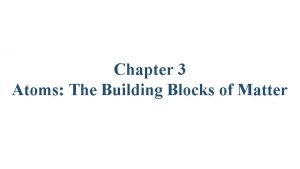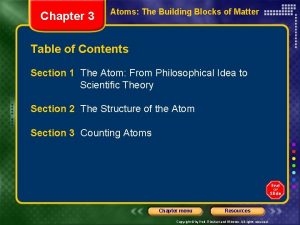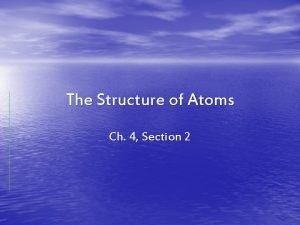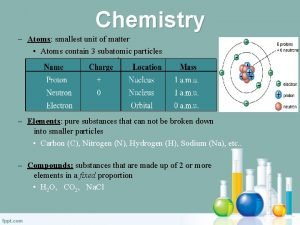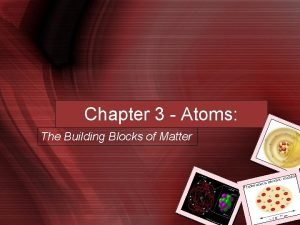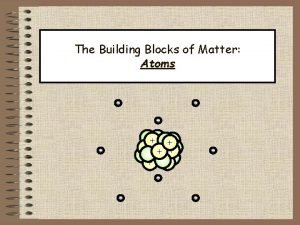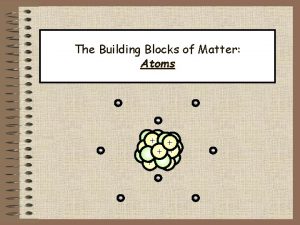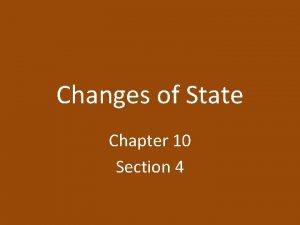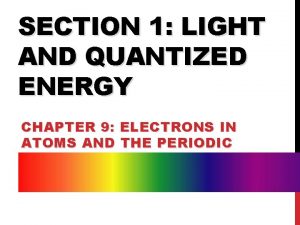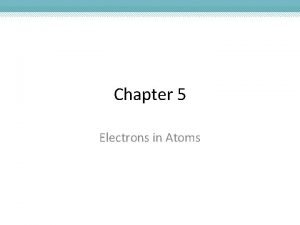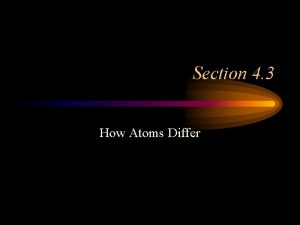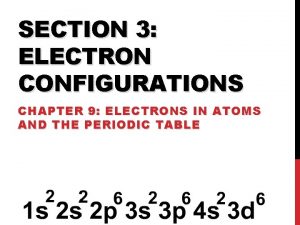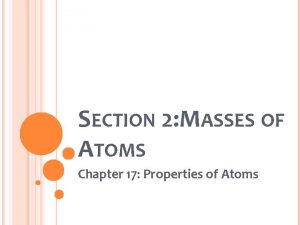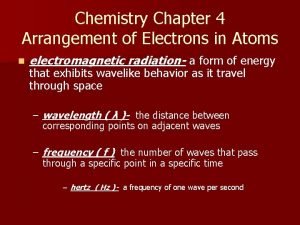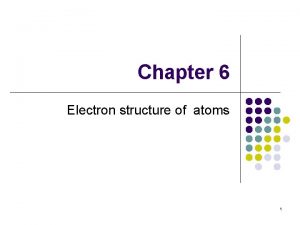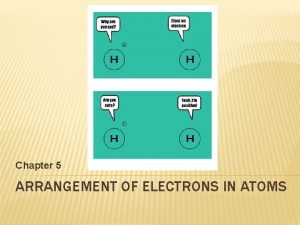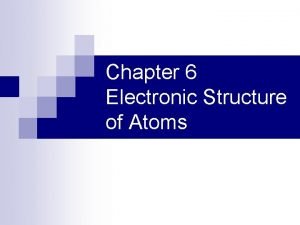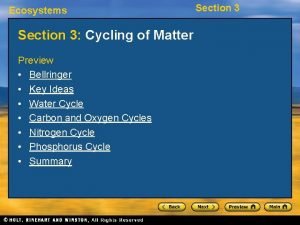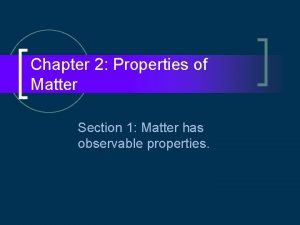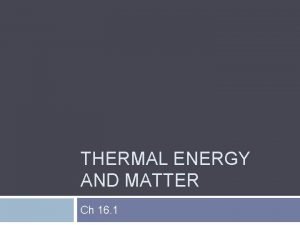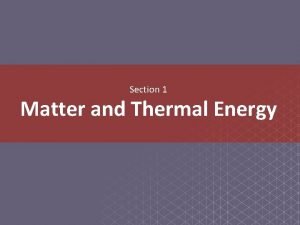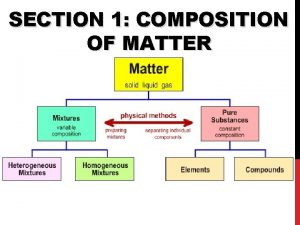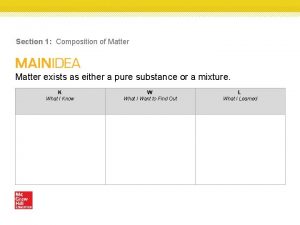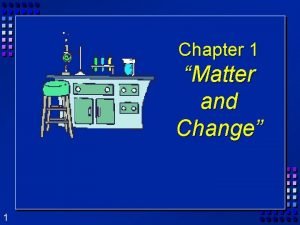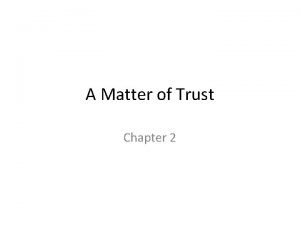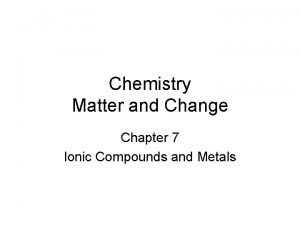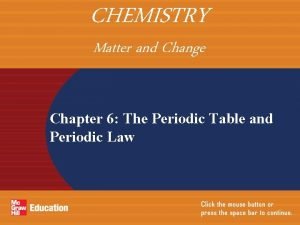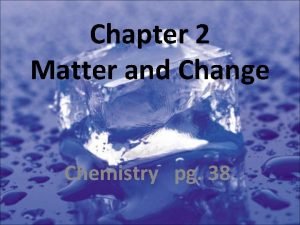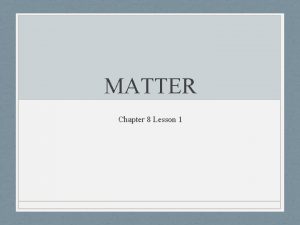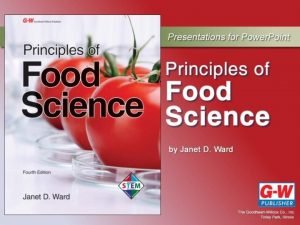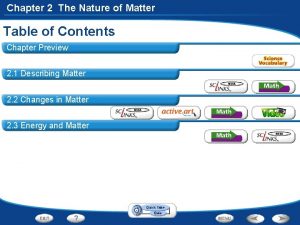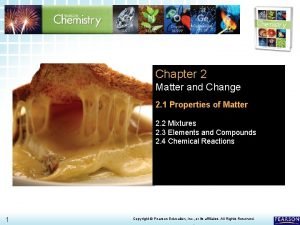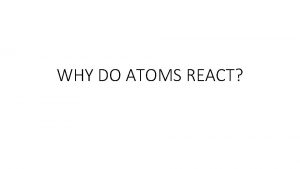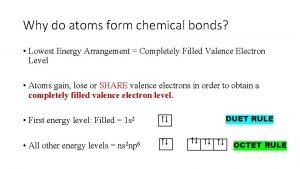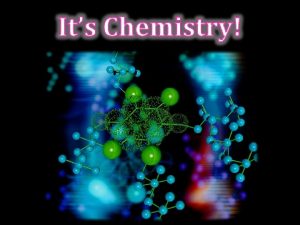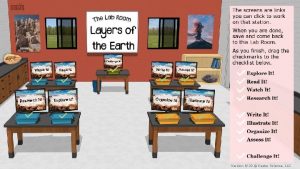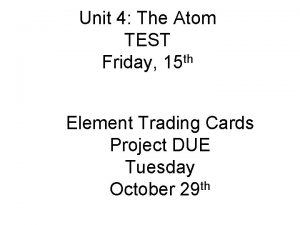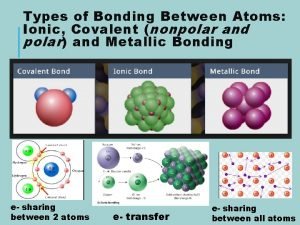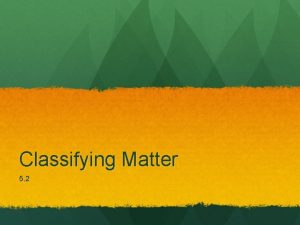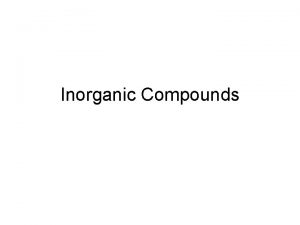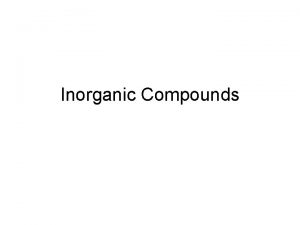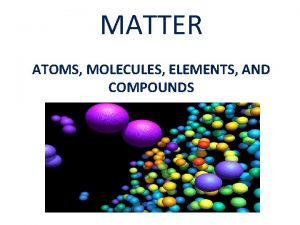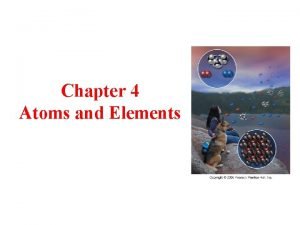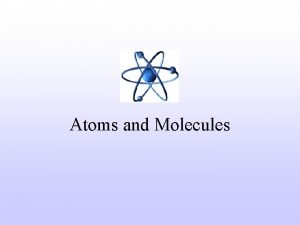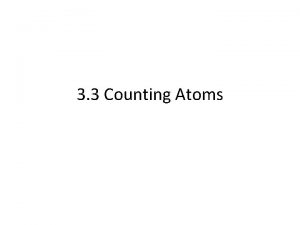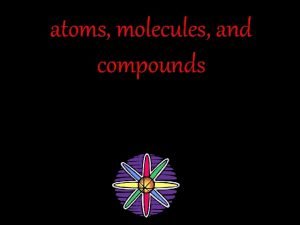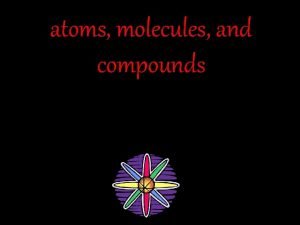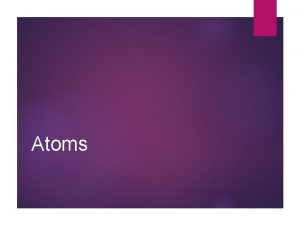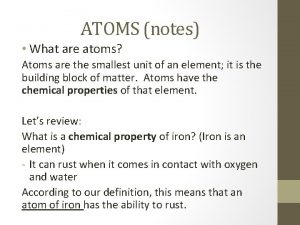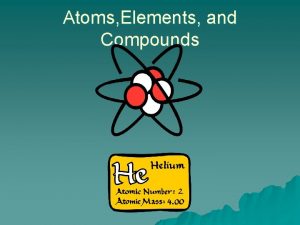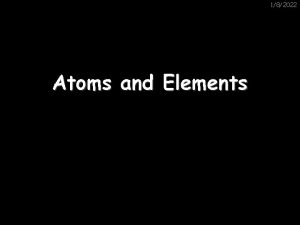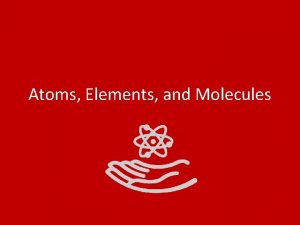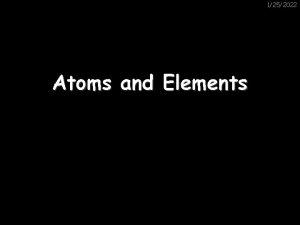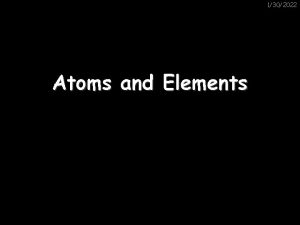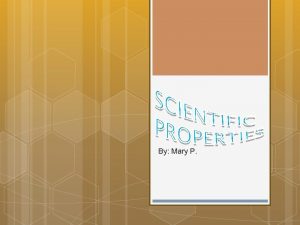Chapter 18 Matter Section 1 Atoms A Matteranything








































































- Slides: 72

Chapter 18 Matter

Section 1 Atoms • A. Matter—anything that has mass and takes up space – 1. Matter is made up of tiny particles called atoms. – 2. Substances that contain only one type of atom are elements. – 3. Elements are found in the Periodic Table



• B. Three basic particles make up an atom: protons, neutrons, and electrons. • 1. Protons and neutrons make up the nucleus of an atom. – a. Protons—particles that have a positive electric charge – b. Neutrons—particles that have no electrical charge – - The nucleus has a positive charge.

• 2. Electrons—negatively charged particles that move around the nucleus – a. Electrons are found in energy levels around the nucleus – b. First energy level can hold 2 electrons – c. Second energy level can hold a maximum of 8 electrons

• d. Third energy level can hold 18 electrons • e. Fourth energy level can hold 32 electron • f. N(squared) x 2 = #of electrons in the energy level (N is the energy level) • g. Draw the model for Carbon, Nitrogen, Chlorine and Sodium – Show the nucleus and electron cloud


• 3. Atomic number—the number of protons in an atom’s nucleus – a. All atoms of a specific element have the same atomic number. – b. This number also equals the number of electrons in the atom’s electron cloud.

• 4. Mass number—the number of protons and neutrons making up an atom’s nucleus

• 5. Using the periodic Table find the number of electrons, protons and neutrons for – a. Na – b. Mg – c. I – d. Cl – e. Au – f. Fe

• C. Isotopes—atoms of the same element that have different numbers of neutrons

• Discussion Question • It was once thought that the atom was the smallest particle possible. Why is that no longer believed? • We now know that atoms are made up of even smaller particles: protons, neutrons, and electrons.

Section 2 Combinations of Atoms


• A. When atoms of more than one element combine, they form a compound. • B. Chemical property—describes a change that occurs when one substance reacts with another substance

• C. Bond—the force that holds atoms in compounds together – - Compound form to become stable – - Atoms are stable when their outer energy level is full or when they have eight electron in their outer energy level – - There are two type of bonds that make compounds

These are the Noble Gases and have very stable electron arrangements eg 2, 2. 8 and 2. 8. 8 because their outer shells are full. The first three are shown in the diagrams below and explains why Noble Gases are so reluctant to form compounds with other elements.

1. Covalent bonds form by sharing electrons. 2. Atoms that combine if they become positively or negatively charged have ionic bonds. – a. They become positive or negative by gaining or losing electrons – b. Electrically charged atoms are called ions. c. Ions are attracted to each other when they have opposite charges.










• Other types of bonds • 3. Metallic bonds—electrons are free to move from one ion to the other. – a. Found in metals such as copper, gold, aluminum, and silver – b. Give metals the ability to conduct electricity



• 4. Hydrogen bonds—form when the positive end of one molecule is attracted to the negative end of another molecule – a. Form without the interaction of electrons – b. Responsible for the property of cohesion —allows water to form raindrops – c. Hydrogen bonds are easily broken.





Water strider not heavy enough to break hydrogen bonds

Cohesion


Cohesion and hydroplaning



Mixture and solutions

• D. Mixture—two or more substances that are not chemically combined – 1. Heterogeneous mixture—components not mixed evenly; each component retains its own properties. – 2. Homogenous mixture—compounds evenly mixed; can’t see each component; also called solutions


Vinegar and oil-heterogeneous

Sugar water- Solution

Homogeneous – Rubbing alcohol isopropanol + water

– 3. The components of a mixture can be separated by physical means. • a. Ex. Marbles from wood chips – 4. The components of a compound must be separated by chemical means. To break down compounds, several steps are required

• Discussion Question • Why are materials with metallic bonds malleable, or easily shaped? • Their electrons are free to move from one ion to the other.

18. 3 Properties of Matter

• A. Physical properties—properties you can observe without changing a substance into a new substance – 1. One physical property is density, which is an object’s mass divided by its volume. – 2. The measurement of density is usually given in grams per cubic centimeter (g/cm 3 ). – 3. An object less dense than water will float in water.

density The concentration of matter in an object

Oil is less dense then water


States of matter

• B. Four physical states of matter: solid, liquid, gas, and plasma – 1. Solids—the matter’s atoms are in a fixed position relative to each other – 2. Liquids—atoms are attracted to each other, but can change positions with each other

– 3. Gases—atoms have almost no attractive force on each other, so atoms move freely and will fill the entire container they are placed in – 4. Plasma—electrons can escape and move outside of the ion’s electron cloud. a. The most common state of matter in the universe • b. Stars and lightning bolts are composed of matter in the plasma state.




Plasma Crest






• C. Matter can change from one state to another. – 1. Changes in state can occur because of increases or decreases in temperature and pressure. • a. Matter is changed from a liquid to a solid at its freezing point. b. Matter is changed from a liquid to a gas at its boiling point. – 2. When matter changes state, its chemical properties do not change, but physical properties may change

• D. Properties of Water – 1. Surface Tension -water is sticky and elastic, and tends to clump together in drops rather than spread out in a thin film. • a. Caused by hydrogen bonds – 2. Only natural substance that is found in all three states -- liquid, solid (ice), and gas (steam)

• 3. Water freezes at 32 o Fahrenheit (F) and boils at 212 o F – a. 0 o on the Celsius scale is water's freezing point, and 100 o is water's boiling point. • 4. Water has a high specific heat index. This means that water can absorb a lot of heat before it begins to get hot.

• 5. Water is called the "universal solvent" because it dissolves more substances than any other liquid. • 6. Ice is less dense then water

• Discussion Question • What happens to its molecules when matter changes from a liquid to a gas? • Atoms spread out and move farther away from one another.
 Chapter 2 section 1 classifying matter answer key
Chapter 2 section 1 classifying matter answer key Chapter 3 atoms the building blocks of matter
Chapter 3 atoms the building blocks of matter Which subatomic particle has the least mass
Which subatomic particle has the least mass At stp which substance is the best conductor of electricity
At stp which substance is the best conductor of electricity Classification of matter section 1 composition of matter
Classification of matter section 1 composition of matter Classification of matter section 1 composition of matter
Classification of matter section 1 composition of matter Section 1 composition of matter chapter 15 answer key
Section 1 composition of matter chapter 15 answer key Chapter 4 section 2 the structure of atoms
Chapter 4 section 2 the structure of atoms Chapter 6 chemistry in biology
Chapter 6 chemistry in biology Chapter 6 section 1 atoms elements and compounds
Chapter 6 section 1 atoms elements and compounds Are atoms the smallest unit of matter
Are atoms the smallest unit of matter Atoms the building blocks of matter
Atoms the building blocks of matter Atoms the building blocks of matter
Atoms the building blocks of matter Building blocks of atoms
Building blocks of atoms Chapter 10 review states of matter section 4
Chapter 10 review states of matter section 4 Chapter 2 section 3 cycling of matter answer key
Chapter 2 section 3 cycling of matter answer key Electrons in atoms section 1 light and quantized energy
Electrons in atoms section 1 light and quantized energy Electrons in atoms section 1 light and quantized energy
Electrons in atoms section 1 light and quantized energy What is the lowest allowable energy state of an atom
What is the lowest allowable energy state of an atom Electrons in atoms section 2 quantum theory and the atom
Electrons in atoms section 2 quantum theory and the atom Chemistry in biology section 2 chemical reactions
Chemistry in biology section 2 chemical reactions Section 3 how atoms differ
Section 3 how atoms differ S orbital
S orbital Section 2 masses of atoms
Section 2 masses of atoms Grey matter reliaquest
Grey matter reliaquest Label the cranial dura septa and associated sinuses.
Label the cranial dura septa and associated sinuses. Gray matter and white matter
Gray matter and white matter What is grey matter
What is grey matter Ecological succession
Ecological succession Chapter 10 section 1 meiosis answer key
Chapter 10 section 1 meiosis answer key Arrangement of electrons in atoms chapter 4 test
Arrangement of electrons in atoms chapter 4 test Stable electron configurations are likely to contain
Stable electron configurations are likely to contain Chapter 6 electronic structure of atoms answers
Chapter 6 electronic structure of atoms answers Chapter 5 arrangement of electrons
Chapter 5 arrangement of electrons Which of the d orbitals most resembles a pz orbital?
Which of the d orbitals most resembles a pz orbital? Chapter 2 atoms molecules and ions
Chapter 2 atoms molecules and ions Section 3 cycling of matter answer key
Section 3 cycling of matter answer key 2 properties of matter
2 properties of matter Which reverses the normal flow of thermal energy
Which reverses the normal flow of thermal energy Section 1 matter and thermal energy
Section 1 matter and thermal energy Section 1 composition of matter
Section 1 composition of matter Section 1 composition of matter answer key
Section 1 composition of matter answer key Section 1 organisms and their relationships
Section 1 organisms and their relationships Section 1 organisms and their relationships
Section 1 organisms and their relationships Chemistry matter and change chapter 7
Chemistry matter and change chapter 7 Chapter 12 states of matter study guide
Chapter 12 states of matter study guide Chapter 10 assessment the mole answer key
Chapter 10 assessment the mole answer key Chapter 1 review matter and change
Chapter 1 review matter and change A matter of trust chapter questions and answers
A matter of trust chapter questions and answers 1s 22 s22 p63 s23 p64 s2
1s 22 s22 p63 s23 p64 s2 Chemistry matter and change chapter 6
Chemistry matter and change chapter 6 Chemistry matter and change chapter 10 the mole answer key
Chemistry matter and change chapter 10 the mole answer key Composition of matter chapter 9
Composition of matter chapter 9 Chemistry matter and change chapter 2 answer key
Chemistry matter and change chapter 2 answer key Chapter 8 lesson 1
Chapter 8 lesson 1 Non examples of homogeneous mixture
Non examples of homogeneous mixture Chapter 4 basic food chemistry the nature of matter
Chapter 4 basic food chemistry the nature of matter Chapter 4 basic food chemistry the nature of matter
Chapter 4 basic food chemistry the nature of matter The nature of matter chapter 2
The nature of matter chapter 2 Chapter 2 properties of matter answer key
Chapter 2 properties of matter answer key Circle the solute and underline the solvent
Circle the solute and underline the solvent Chapter 11 - states of matter: liquids and solids
Chapter 11 - states of matter: liquids and solids This view represents
This view represents Difference between revolved and removed section
Difference between revolved and removed section Viewing plane line symbol
Viewing plane line symbol Section 2 describing energy (continued)
Section 2 describing energy (continued) C3h5 name
C3h5 name Expanded octet
Expanded octet What is the relationship between atoms and elements
What is the relationship between atoms and elements What are atoms?
What are atoms? Kesler science crossword answer key
Kesler science crossword answer key The atoms family atomic math challenge answer key
The atoms family atomic math challenge answer key Ionic metallic and covalent bonds
Ionic metallic and covalent bonds

